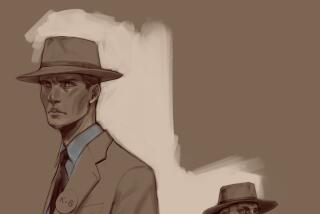Henry Bumstead, 91; Veteran Film Production Designer
- Share via
Henry Bumstead, the veteran Hollywood production designer who won Academy Awards for his work on “To Kill a Mockingbird” and “The Sting” and whose longtime association with actor-director Clint Eastwood kept him on the job into his 90s, has died. He was 91.
Bumstead, who reportedly had prostate cancer, died Wednesday in Pasadena, his family said.
In a nearly 70-year career that began when he was a draftsman in the art department at RKO in the late 1930s, Bumstead’s first picture as an art director was the 1948 Paramount drama “Saigon,” starring Alan Ladd.
Bumstead received his Academy Awards for his depiction of 1930s rural Alabama in director Robert Mulligan’s 1962 drama “To Kill a Mockingbird” and for re-creating Depression-era Chicago in George Roy Hill’s 1973 comedy-drama “The Sting.”
He also received Oscar nominations for his work on Alfred Hitchcock’s 1958 romantic thriller “Vertigo” and for Eastwood’s 1992 western “Unforgiven.”
Bumstead, who was affectionately known as Bummy, had more than 100 films to his credit, including “Come Back, Little Sheba,” “Cinderfella,” “The Great Waldo Pepper,” “Slap Shot,” “The Front Page,” “Tell Them Willie Boy Is Here,” Martin Scorsese’s 1991 version of “Cape Fear,” “Mystic River” and “Midnight in the Garden of Good and Evil.”
Bumstead recently completed work on Eastwood’s companion movies “Flags of Our Fathers” and “Red Sun, Black Sand,” the last of a 13-film collaboration.
“Bummy was one of a kind,” Eastwood said in a statement Friday. “He seamlessly bridged the gap between what I saw on the page and what I saw through the camera lens. He is a legend in his field and a cherished friend. We will all miss him terribly.”
Bumstead once described his job as a production designer by saying, “In a nutshell, my job is to break down the script, find the best possible locations, make a budget and design the appropriate sets that correspond to the story.”
For Eastwood’s 2002 crime thriller “Blood Work,” which was shot in and around Los Angeles and Long Beach, he built the elaborate interior of an old freighter with a flooded engine room.
“That was a big set, and I got to do some wonderful aging,” Bumstead told The Times in 2002. “I’m a stickler for aging -- the rust and the dirt. It was just a beautiful set.”
The tall and bearish Bumstead was an unpretentious, down-to-earth survivor of the old Hollywood studio system.
“I love doing films,” he said in a 2002 interview with the Dallas Morning News in which he made note of his career longevity and said, “I’ve never been laid off, I’ve never been fired and I’ve never looked for a job.”
In the same interview, Bumstead added: “I wouldn’t be working now at my age if it weren’t for Clint Eastwood.”
Their professional relationship began on the 1972 western “Joe Kidd,” directed by John Sturges and starring Eastwood. That was followed by the Eastwood-directed 1973 western “High Plains Drifter.”
While working on “Million Dollar Baby,” Eastwood’s Oscar-winning 2004 drama about a female boxer starring Eastwood and Hilary Swank, Bumstead learned that he had prostate cancer.
“Clint furnished me with a car and driver and a wheelchair,” he told Daily Variety last year. “I went through radiation and chemotherapy, but I was still able to work for him.”
“What really makes him invaluable is that he has a great reservoir of memory and technique of working with everybody from Hitchcock to [Billy] Wilder,” Eastwood told Variety. “Of that era, he’s the last man standing.”
Lloyd Henry Bumstead was born in Ontario on March 17, 1915.
He received a scholarship to USC, where he briefly played football and studied architecture.
After finishing his sophomore year, he received a call to work at RKO for the summer as an apprentice draftsman at $35 a week.
In 1937 he went to work at Paramount and, he recalled in a 2005 interview with MovieMaker magazine, “That was when I made the decision to make movies my life.”
At Paramount, he worked for German-born art director Hans Dreier, who headed the art department and provided Bumstead with a valuable lesson. As he told MovieMaker:
“One day, he walked into my office, briefly looked over my sketches, nodded his head and said, ‘Ah-ha! The character who inhabits that room must be a very learned man.’ Then he walked away. I didn’t know what he meant, so I went back to the script, re-read it and shook my head because the main character was anything but an educated person.
“When I looked at my drawing, I realized that I had designed the main character’s house with more bookcases than you would find in most people’s homes. The bulb went on and I realized my first lesson: Design sets that are livable for the specific type of people who inhabit them, and don’t try to show every trick you know.”
Bumstead, who enlisted in the Navy during World War II and was stationed in Washington, D.C., said in the 2002 Times interview that he also was taken under the wing of Dreier’s assistant, Roland Anderson, who was Cecil B. DeMille’s art director.
“I worked for him seven years before I became an art director,” Bumstead said.
He was working on director Michael Curtiz’s 1956 costume drama “The Vagabond King” when he was recommended to Hitchcock for the director’s 1956 thriller “The Man Who Knew Too Much.”
In addition to “Vertigo,” Bumstead also worked on Hitchcock’s 1969 film “Topaz” and his 1976 film “Family Plot,” the director’s final movie.
In 1998, Bumstead received the Art Directors Guild’s lifetime achievement award.
He is survived by his wife of 23 years, Lena; three sons, Robert, Marty and Steven; a daughter, Ann Jones; two stepdaughters, Carolyn Ehret and Sue-Ellen Gittings; and 11 grandchildren.
The family requests that contributions in Bumstead’s memory be made to the USC School of Architecture, care of Dottie O’Carroll, Watt Hall 204, Los Angeles, 90089-0291.
More to Read
Only good movies
Get the Indie Focus newsletter, Mark Olsen's weekly guide to the world of cinema.
You may occasionally receive promotional content from the Los Angeles Times.










